Serving 23 students in grades Prekindergarten-3, Anderson Island Elementary School ranks in the bottom 50% of all schools in Washington for overall test scores (math proficiency is top 50%, and reading proficiency is bottom 50%).
The percentage of students achieving proficiency in math is <50% (which is equal to the Washington state average of 50%). The percentage of students achieving proficiency in reading/language arts is ≥50% (which is lower than the Washington state average of 61%).
The student:teacher ratio of 8:1 is lower than the Washington state level of 16:1.
Minority enrollment is 31% of the student body (majority Hispanic), which is lower than the Washington state average of 52% (majority Hispanic).
Quick Stats (2025)
- Grades: Prekindergarten-3
- Enrollment: 23 students
- Student:Teacher Ratio: 8:1
- Minority Enrollment: 31%
- Math Proficiency: <50% (Top 1% in WA)
- Reading Proficiency: ≥50% (Top 1%)
- Source: National Center for Education Statistics (NCES), WA Dept. of Education
Top Rankings
Anderson Island Elementary School ranks among the top 20% of public schools in Washington for:
Category
Attribute
Community Size
Student Attention
School Overview
Anderson Island Elementary School's student population of 23 students has declined by 8% over five school years.
The teacher population of 3 teachers has grown by 50% over five school years.
Grades Offered
Grades Prekindergarten-3
Total Students
23 students
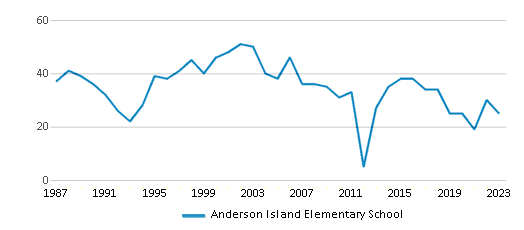
Gender %
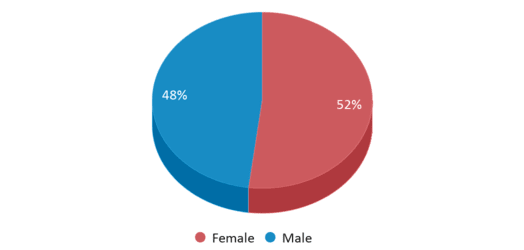
Total Classroom Teachers
3 teachers
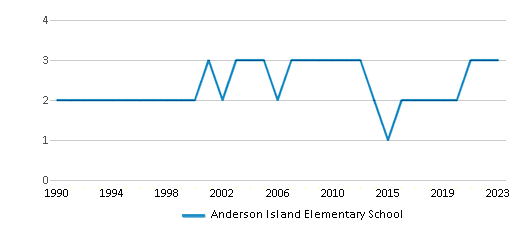
Students by Grade
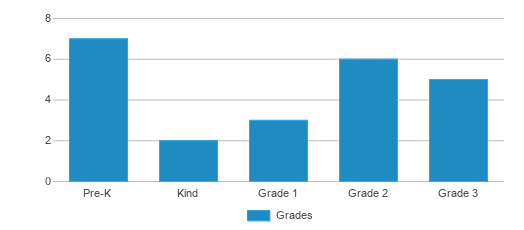
School Rankings
The diversity score of Anderson Island Elementary School is 0.47, which is less than the diversity score at state average of 0.69. The school's diversity has stayed relatively flat over five school years.
Math Test Scores (% Proficient)
(18-19)<50%
50%

Reading/Language Arts Test Scores (% Proficient)
(18-19)≥50%
61%
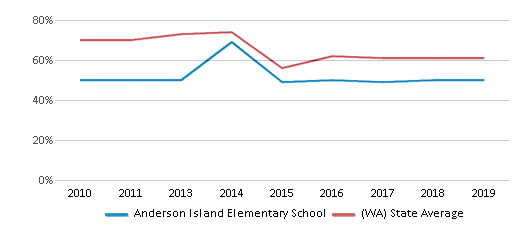
Student : Teacher Ratio
8:1
16:1
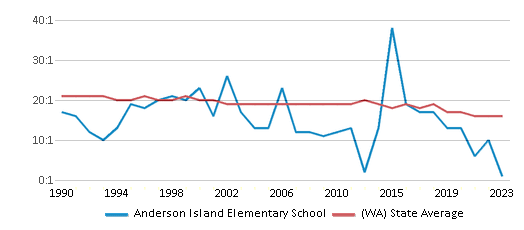
American Indian
n/a
1%
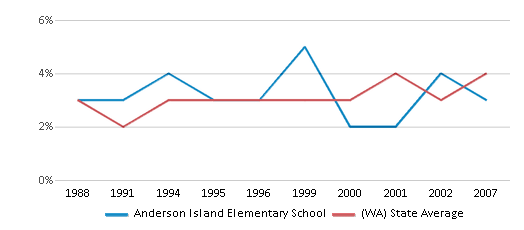
Asian
n/a
9%
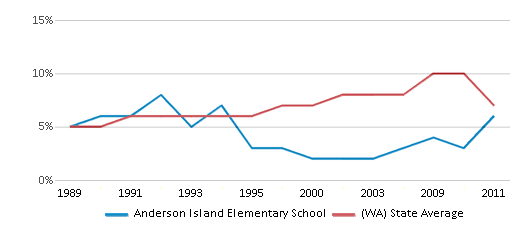
Hispanic
9%
26%
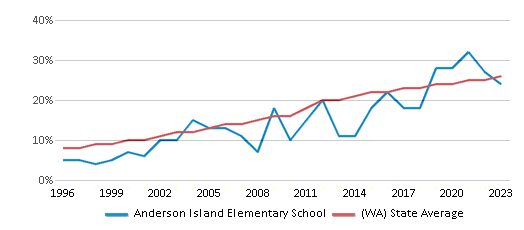
Black
n/a
5%
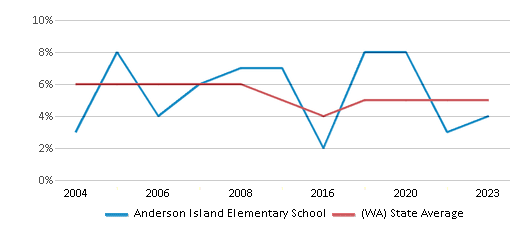
White
69%
48%
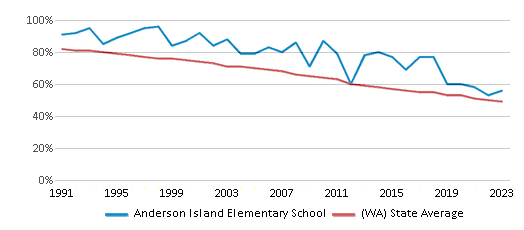
Hawaiian
n/a
2%
Two or more races
22%
9%
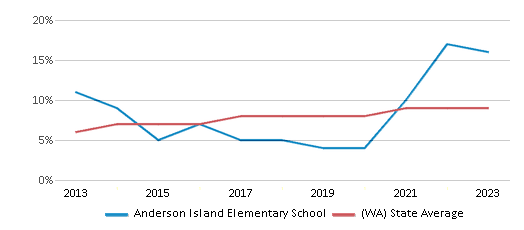
All Ethnic Groups
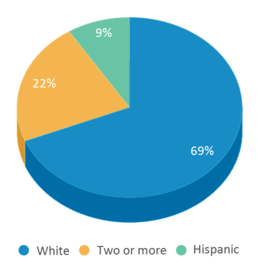
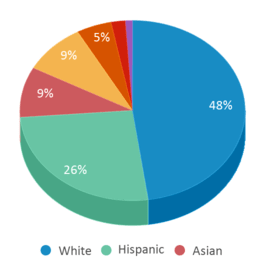
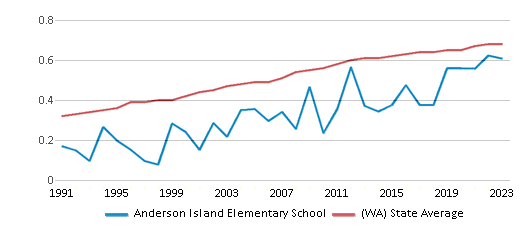
Eligible for Free Lunch
52%
49%
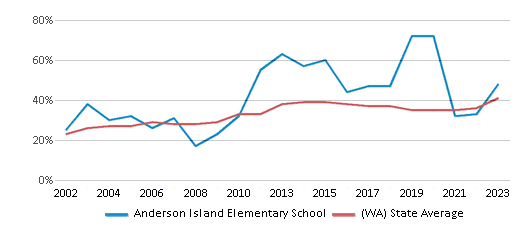
Eligible for Reduced Lunch
16%
8%
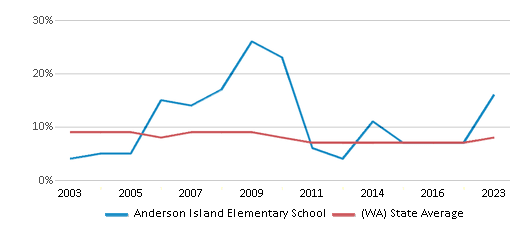
School Statewide Testing
School District Name
Source: National Center for Education Statistics (NCES), WA Dept. of Education
Profile last updated: 02/09/2025
Frequently Asked Questions
What percent of students have achieved state testing proficiency in math and reading?
<50% of students have achieved math proficiency (compared to the 50% WA state average), while ≥50% of students have achieved reading proficiency (compared to the 61% WA state average).
How many students attend Anderson Island Elementary School?
23 students attend Anderson Island Elementary School.
What is the racial composition of the student body?
69% of Anderson Island Elementary School students are White, 22% of students are Two or more races, and 9% of students are Hispanic.
What is the student:teacher ratio of Anderson Island Elementary School?
Anderson Island Elementary School has a student ration of 8:1, which is lower than the Washington state average of 16:1.
What grades does Anderson Island Elementary School offer ?
Anderson Island Elementary School offers enrollment in grades Prekindergarten-3
What school district is Anderson Island Elementary School part of?
Anderson Island Elementary School is part of Steilacoom Hist. School District.
School Reviews
3 5/6/2021
My child attended this school starting in Kinder. She struggled. I kept constant communication with the teachers & principal. I asked them what could be done. They had no options & ignored most communications. School avoidance got so bad and my kid who LOVED learning before kinder steadily refused more & more everyday learning things we had in the home like reading before bed, hiking & plant identification etc etc... she started hating everything about learning. One day she came home excited because she thought she had done really well and would get a flyer award. It was an award given to a few kids each week for being good in school. She said she followed all the rules. The next day she came home so so angry & deeply sad. I asked how the awards went. She didn't have an award in her backpack. My 6yo looked at me & said, I think I am a bad kid and starting crying. So for her mental health &my own I was forced to remove her from the school the very next day. This was after many attempt to seek Special Education under IDEA. She missed the last part of kindergarten & the first part of first grade which I fought with the school over assessments, IEP & accommodation. Finally she went back in February PT for the rest of the 1st grade year. They followed the IEP, and she started to have an easier time in school. She had 1-on-1 support & school avoidance stopped. Then cue second grade. The teacher hadn't reviewed the IEP. The accommodations from it were not in place in the classroom & they would not work with me to make the transition easier. School avoidance started again almost immediately & got worse until one day upon school drop off she got out of the car, froze at the fence to go in & immediately had a panic attack. All the teachers, aids & staff were on the field, watched her struggling with the transition and DID NOTHING. In fact they proceeded like they couldn't see her, rounded up the kids as normal and went to the multi-purpose room to start the day. A mom friend helped by going in and retrieving a teacher to help. That teacher came out and said to me, What do you expect me to do. I can''t put my hands on her. Then she turned around and walked back inside. I had to pull her out of school. I have filed citizen complaints, had mediators for IEP meetings, I have reported them to OSPI, we got an IEE. Now that she is about to go to the school across the water, NOW they are offering supports but it's too little too late. The damage is already done.
Review Anderson Island Elementary School. Reviews should be a few sentences in length. Please include any comments on:
- Quality of academic programs, teachers, and facilities
- Availability of music, art, sports and other extracurricular activities
Recent Articles

What Is A Charter School?
Explore the world of charter schools in this comprehensive guide. Learn about their history, how they operate, and the pros and cons of this educational innovation. Discover key facts about charter schools, including admission policies, demographics, and funding, as well as what to look for when considering a charter school for your child.

10 Reasons Why High School Sports Benefit Students
Discover the 10 compelling reasons why high school sports are beneficial for students. This comprehensive article explores how athletics enhance academic performance, foster personal growth, and develop crucial life skills. From improved fitness and time management to leadership development and community representation, learn why participating in high school sports can be a game-changer for students' overall success and well-being.

February 05, 2025
Understanding the U.S. Department of Education: Structure, Impact, and EvolutionWe explore how the Department of Education shapes American education, from its cabinet-level leadership to its impact on millions of students, written for general audiences seeking clarity on this vital institution.





